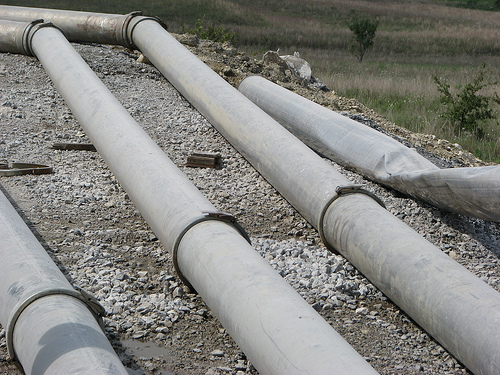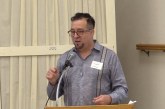 Were it not for the fact that Fire Chief Bill Weisgerber took the time to explain the level of risk to Davis residents, and the difference between the distribution lines which tend to be about 2 inches in diameter in Davis, while the transmission line in San Bruno that led to the catastrophic explosion was 30 inches in diameter, we would be alarmed that PG&E was hiding something.
Were it not for the fact that Fire Chief Bill Weisgerber took the time to explain the level of risk to Davis residents, and the difference between the distribution lines which tend to be about 2 inches in diameter in Davis, while the transmission line in San Bruno that led to the catastrophic explosion was 30 inches in diameter, we would be alarmed that PG&E was hiding something.
However, a conversation with Fire Chief Bill Weisgerber clarified the situation.
“Anytime there’s a gas leak and there’s a source of ignition, you can have a problem,” the Chief told the Vanguard this morning. “I know everyone is thinking the San Bruno transmission line, but these are actually the smaller, what they call distribution lines, they’re probably two-three inches in diameter.”
“Even those do present a problem if they start to leak,” the Chief said. “But typically it’s a less severe risk -you aren’t as likely to see an explosion.”
The city is attempting to set up a community meeting for the 10th or 16th of November, and Mayor Joe Krovoza is urging PG&E “to issue the clearest possible statement” on critical questions arising from the community.
However, if the Vanguard’s experience with PG&E’s media people Brittany McKannay and Paul Moreno is any guide, we can see the frustration of the neighbors, and we have our own concerns about whether PG&E is going to be honest with the public on this matter.
“This is a public safety issue, not a public relations issue,” said David Johnson, a neighborhood spokesperson who has experienced two recent gas leaks on his property. “We need to notify homeowners where known trouble spots are located. If there is a cluster of historical gas leaks in a certain area, residents need to be notified as soon as possible.”
For a company stung by the San Bruno tragedy, the evasiveness is disconcerting.
The Vanguard asked what should have been a softball question: “Do you view this at this point as a health and safety threat, or is this just a minor nuisance at this point?”
Ms. McKannay responded: “Well, our customer concerns are never a minor nuisance,” she said, chuckling a bit. “And that’s why we’ve worked tirelessly to make sure that we are hearing what our customers have to say. We are constantly communicating with city officials and the fire department, and we’re addressing concerns. That hasn’t just taken place in the last few weeks – that’s taken place continuously.”
She provided examples of partnerships with first responders on training seminars, and they did one in September where the Davis Fire Department participated.
“We’re constantly making sure that we’re interactively communicating with first responders and elected officials because we want to have that open line of communication and discussion on how to deal with these situations safely. And also making sure that they know that they can come to us with concerns.”
Nice answer, except she never really addressed my safety point. She must have overlooked that, so I asked it more pointedly.
Vanguard: “But is this a safety threat?”
Ms. McKannay responded: “At this point we are addressing the possibility of leaks, so we’re getting out to the area to be sure if there are leaks, they’re being repaired. So we’re absolutely addressing any concerns or issues that might take place as soon as possible.”
At this point Mr. Moreno also explained: “We’re taking steps to doing this initial leak survey, that is continuing this week, as well ones that we’re doing every other week. If we discover a leak, we’ll fix it immediately.”
Vanguard: “That I understand, but I guess what I’m trying to assess is – if you had to rate the level of threat to people’s safety on a scale of 1 to 10, where would you put it, faced with this situation?”
Ms. McKannay: “I can’t provide a rating at this point between one and ten, but what I can say is that we are in the area making sure that the lines are being monitored and that if an issue arises, we’re addressing it right away.”
Let me just interject here, that, of course, we know that they will address an issue as it arises right away. I’m sure they addressed the issue in San Bruno right away too, but it was so severe there was not much they could do.
If there is a threat, then tell us what it is, and we can assess for ourselves how worried to be.
Instead, Ms. McKannay continued: “I think there’s also a role that we’ve discussed with the customers and we’ll continue to communicate that they can play in regard to public safety. And that is, if they smell natural gas they should call 911 and contact PG&E and we will come out to the area and survey it and find out what’s going on.”
Now, of course, I was taught that you only call 911 if it is an emergency. So now they are admitting (without actually articulating it), that having a gas leak is a potential emergency situation.
Ms. McKannay continued, “It really is a collaborative effort that we’re putting in place today, that this is a safe and reliable service that we’re providing.”
So now I’m starting to sense that maybe they are trying to dodge this issue, so I try again, “Let me ask the question this way, if there’s a gas leak, and somebody starts a car and there’s a spark, is their car going to explode or is there a fire threat from that?”
Ms. McKannay: “That’s what we’re talking about when we refer to the leak survey. So you say there’s a gas leak, we have a crew out there now every other week surveying the line and if there was a leak they would be repairing it immediately.”
Mr. Moreno may have realized that I was getting frustrated, as he added: “Realize, David, that this equipment that we use is highly sensitive so it can detect very minute levels of gas which would be well before anyone was able to smell that gas.”
Vanguard: “Already six people have detected leaks and had to either call the fire department or PG&E to repair those, so I guess what I’m trying to figure out – obviously we’re not looking at a San Bruno situation but what are people facing if something went wrong?”
Now, I thought at this point, I was handing them a freebie to say this is not San Bruno and explain the difference between San Bruno and the tiny distribution lines in Davis. While I understand that Ms. McKannay has not been on the job very long, Mr. Moreno has no such excuse here.
PG&E’s response from Mr. Moreno: “We can’t respond to a speculative question.”
A risk assessment question is not speculative.
He continued, “What we can tell you, as Brittany has outlined, we have in place an integrity management program that is examining issues on our entire system and is coming up with a process of prioritizing how we would replace or increase leak patrol.”
At this point, I shifted the line of questioning, realizing that there was no way they could answer the question in five minutes, a question that took our fire chief about 10 seconds to address.
So again, the correct answer, at least according to our fire chief, whom I suddenly trust a lot more than the PR people from PG&E, is that while any leak is potentially a problem and a safety risk, we are not dealing with the huge transmission lines that were in play at San Bruno and, given the small size of these pipes, an explosion is unlikely.
However, if the Chief is recommending a 911 call, then we know this is still a potentially serious situation that we must assess with extreme caution.
I hope the city can get PG&E, when it meets with the public, to be more forthright about risks than they were with the Vanguard.
—David M. Greenwald reporting






Let me relay an experience I have had with PG&E. As a volunteer attorney for Senior Legal Hotline, I had a client living in a Sacramento Section 8 duplex who kept smelling gas. I instructed him to immediately notify PG&E. PG&E refused to come out to inspect, bc my client still had money owing on his bill. So I directed my client to have his next door neighbor contact PG&E, since the next door neighbor was current on his utility bill. PG&E did come out and inspect when called by the neighbor. The PG&E inspector found a hole the size of a golf ball in some heating equipment out of which gas was leaking. The inspector said it was a good thing his company (PG&E) was contacted, bc the entire duplex could have exploded at any second.
I also wondered how much health damage had been done to both resident families from breathing in all that natural gas from the leak, which had most likely been there for some time. The landlord in the case was in essence a slum lord.
To make a long story short, Section 8 people had been aware for some time this landlord rented places that were uninhabitable. But Sec 8 inspectors could not seem to make any headway with resident complaints to upper management in charge of Sect 8 housing. Eventually the health dept came in and closed this landlord down, and forced the landlord to pay for the necessary changes to the premises.